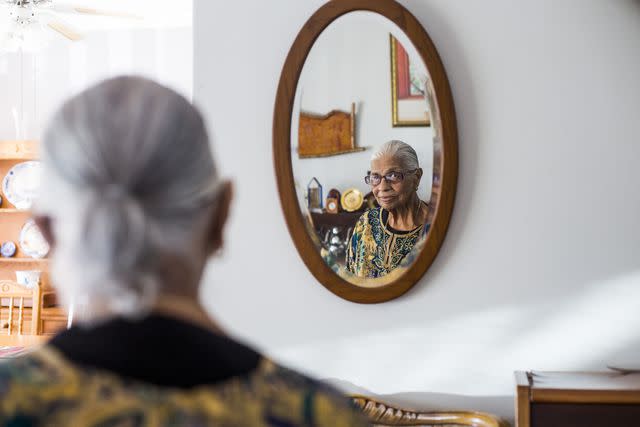Can Macular Degeneration Cause Visual Hallucinations?
Hallucinations From Charles Bonnet Syndrome
Medically reviewed by Andrew Greenberg, MD
Macular degeneration can lead to vision loss. In turn, people with vision loss may experience visual hallucinations (seeing things that aren't there). This is known as Charles Bonnet syndrome (CBS). One study estimates that more than 12% of people with macular degeneration experience visual hallucinations.
The article discusses visual hallucinations and how they are linked to age-related macular degeneration (AMD), as well as treatments to manage them.

Lauren Mulligan / Getty Images
What Are Visual Hallucinations?
Visual hallucinations linked to Charles Bonnet syndrome involve seeing things that aren't there. In CBS, these hallucinations are not connected to mental health or cognitive issues. CBS occurs in those who have lost a significant amount of vision due to conditions such as macular degeneration, cataracts, or stroke.
Images seen by those with this condition appear to take place in real-world surroundings, not internally, as one might view a memory. These hallucinations can be fleeting, lasting just seconds, or may linger for a day or so.
While CBS is more common if both eyes have vision loss, it can affect just one eye with vision problems as well. It also can occur with either wet or dry macular degeneration. However, if you lose vision rapidly, such as with a bleed associated with wet macular degeneration, then you may be more prone to developing the condition.
The condition itself may only last a few days or can continue chronically for years. But it may become less frequent over time.
Examples and Vision Effects
Examples of visual hallucinations in CBS are:
Lines or shapes
Grid patterns
Flashes of light
Elaborate vistas
Disembodied faces
Seeing people who are not there
Detailed images
Animals
Flowers
Moving images
Why Wet Macular Degeneration Progresses Quickly
With wet macular degeneration, abnormal blood vessels develop in the retina, the light-sensing tissue in the back of the eye. These vessels are not as strong as normal blood vessels. Without warning, they can leak fluid onto the light-sensitive retina and scar it.
The retina is responsible for conveying visual information to the brain, and this scarring leads to rapid vision decline. But if caught quickly and treated, vision loss may be averted.
Visual Hallucinations in Macular Degeneration
Experiencing hallucinations with CBS usually occurs in those over age 80 but can occur in younger people.
Those with hallucinations are generally aware that these are not real and don't tend to be frightened by them, although they may find them annoying. They also tend to be purely visual, with no accompanying sounds.
CBS is not a symptom that affects everyone with AMD-related vision loss. Up to 30% of those with vision impairment in both eyes may experience this condition.
However, some with CBS may be reluctant to share what they are experiencing with others. They may be concerned that others will think they have a mental issue that requires a psychiatric evaluation.
They may also worry about what it means for their macular degeneration and whether it is a sign their condition is worsening. The fact is that CBS can occur in those who have only a few blind spots with minimal vision loss.
The theory is that to compensate for the lack of visual signals that the brain receives from the eyes, some spontaneous nerve activity that normally would be suppressed gets through, resulting in the images that may be seen with this condition.
Images can be in color or black and white. If the part of the brain responsible for color is the area releasing signals, the images will be in color.
The hallucinations usually occur in darkened environments, such as a dark room or at night, and to older people with vision loss who tend to be isolated. With time, hallucinations tend to diminish as the brain adapts to receiving less visual input.
Treatments to Manage Hallucinations in AMD
Although there is, unfortunately, no way to cure CBS, you can learn to manage it effectively. Once your ophthalmologist (medical doctor who is an eye care specialist) confirms that you have CBS, you can begin applying strategies to help yourself cope, such as the following:
Adjust your environment to counteract the hallucination. For example, if you're in a darkened room when a hallucination occurs, switch on a light and give your brain some new visual input.
Try looking at something else, blinking, or moving your eyes from side to side.
Move around and focus your attention elsewhere.
Divert your attention by talking to someone in the room or turning on the TV.
Make sure you're getting all the rest you need so you have the energy to cope with challenges.
Do what you can to enhance your remaining vision, such as making use of magnifying glasses or brighter light.
Also, CBS is a relatively common occurrence, and it can help to discuss it with others so you don't have to shoulder it all on your own.
When to See a Healthcare Practitioner
While CBS hallucinations may be worrisome at first, by no means are they a sign of mental illness. Still, if you are troubled by seeing these, then you should reach out to a healthcare provider.
A provider may be able to recommend a counselor to talk to about the visual hallucinations or support groups for people with similar concerns.
Summary
Those with Charles Bonnet Syndrome develop visual hallucinations that stem from vision loss. Without the usual amount of visual signals in the mix, the brain may spontaneously generate some nerve activity of its own.
The hallucinations are visual images ranging from shapes and patterns to detailed images of people, pets, and more. The condition can be fleeting or could persist for years, but it tends to diminish over time and is not connected to mental illness.
Read the original article on Verywell Health.

